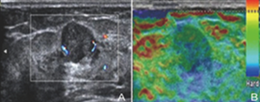The value of elastography strain rate ratio in benign and malignant BI-RADS-US 3-4 breast masses
DOI:
https://doi.org/10.17305/bb.2023.9878Keywords:
Ultrasound elastography (UE), breast masses, strain rate ratio (SR), Breast Imaging Reporting and Data System (BI-RADS) classification, receiver operating characteristic (ROC) curveAbstract
In the realm of breast diagnostics, Breast Imaging Reporting and Data System (BI-RADS) serves as a systematic framework, guiding a methodical exploration into the nuanced narratives of masses. The current study aims to investigate the value of strain rate ratio (SR) of elastography for benign and malignant breast masses categorized by BI-RADS for Ultrasonography (BI-RADS-US) category 3-4. Ultrasonographic data of 1099 breast masses that underwent both elastography and pathological examination were retrospectively analyzed by non-parametric test, consistency analysis and receiver operating characteristic (ROC) curve sequentially. ROC curve was used to evaluate the diagnostic effect of SR method in different BI-RADS categories of breast lesions. The maximum Youden index obtained from the ROC curve was 0.845. At a cut-off value of 3.57, the SR values’ diagnostic sensitivity, specificity, accuracy, positive predictive value and negative predictive value for distinguishing benign and malignant breast lesions were 85.7 %, 98.8 %, 93.6 %, 97.9 % and 91.45 %, respectively. Consistency analysis showed that the consistency between SR value and pathological diagnosis was 93.6 % (κ = 0.864). In addition, the SR values between benign and malignant lesions of BI-RADS 3 and 4 were statistically different (P < 0.001). ROC analysis indicated that the diagnostic area under curve (AUC) for SR value in BI-RADS 3, 4a, 4b and 4c lesions were 0.985, 0.866, 0.793 and 0.916, respectively. In addition, the study observed 58 cases of missed diagnosis and 20 cases of misdiagnosis in evaluating benign and malignant breast lesions. The elastic SR ratio method has a good diagnostic value for the evaluation of breast masses, particularly for lesions with a score of 3-4. The elastic SR ratio method is instrumental in enhancing the accuracy of diagnosis.
Citations
Downloads

Downloads
Published
Issue
Section
Categories
License
Copyright (c) 2023 Xinping Li, Weixu Sun, Hongbiao Zhang

This work is licensed under a Creative Commons Attribution 4.0 International License.
How to Cite
Accepted 2023-11-13
Published 2024-05-02









